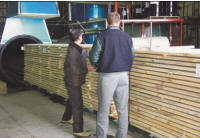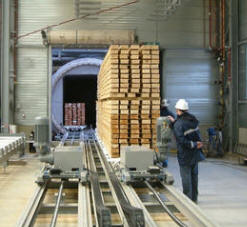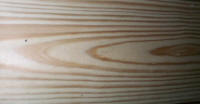
Return To Deck Specialists Inc Home Page
|
Pressure treated outdoor wood then and now For many years PT (pressure treated wood) dominated
the residual market, sold everywhere at lumberyards and home PT wood was considered safe at the time when proper
handling procedures were followed. It was readily available, and
apparently cheap enough to produce as PT wood prices were very
affordable. Water based CCA replaced much nastier oil based wood
treatments like creosote (made from coal tar) and pentachlorophenol
(PCP) a very effective crystalline fungicide. Since 2004 the CCA (chromated copper arsenate) pressure treated process for outdoor deck wood was discontinued from residential use do to possible health concerns from long term exposure to the arsenic in the formula. Remember, arsenic is not a man made chemical but a metallic natural element with poisonous attributes. Since then other pressure treated formulas and processes have entered the marketplace to fill the void left by CCA. The first generations replacement formulas that immediately became readily available are CBA (copper boron azole) and ACQ (alkaline copper quaternary). Essentially using the same process of pressure treatment, chemical fluid forced deeply into wood cells under pressure in a large vacuum chamber, but now using different formulas. The pressure treating process uses copper along with a co-biocide( a chemical added to protect from insects, fungi and decay) to protect the wood. ACQ uses a quaternary compound(Quats antimicrobial salt from quaternary ammonium) ,CBA uses Azole(a synthetic antifungal agent) whereas CCA used arsenic. An organic solvent is also used to dissolve the copper into an aqueous solution for better penetration like alkaline in the ACQ formula. 
One of the biggest issues with these replacement formulas is the
corrosive properties associated with the higher levels of a more
chemically active form of copper which reacts galvanically with the
metal fasteners, flashing and deck hardware. As a result all aluminum,
steel and lesser galvanized hardware was deemed not suitable for use
with ACQ and probably CBA as well. The high cost of all this extra
copper eventually lead to lower retention level formulas, and likely
shorter lifespan of treated wood. Also these formulas tend to more
easily leach their copper out of the wood then the original CCA formula.
We are now looking at a new generation
of Pressure treating processes using micronized copper formulas
MCQ or MicroPro (similar to ACQ) and MCA from copper azole. The copper
in the formulas is “micronized” or processed Other forms of treating wood There
are plenty of other ideas and processes to make otherwise unsuitable
wood species last outdoors without using these conventional water based
chemical bath pressure treating. TimberSil SIL uses a non toxic process of infusing
microscopic particles of sodium silicate (basically glass) in an
aqueous(water based) solution into wood cells. This amorphous glass
barrier that parallels the grain of the wood protects the wood fibers
from rot and decay and promises to actually strengthen the wood and
offer fire retardation.
http://www.timbersilwood.com/ Viance (DCOIT) you’ll like this
formula( 4,5-Dichloro-2-n-Octyl-3-Isothiazolinone-3-one) a non-metallic
preservative plus stabilizer system. Looks like some sort of chlorine
and bromine combination, said to protect wood from decay and insects and
wood stabilizer polymer reduces cracking warping and splitting.
http://www.treatedwood.com/ecolife/ Pure wood’s process: (TMW)no
chemicals added thermally modified wood, of heat treating wood (up to
480 degrees) where the wood sugars are converted into a natural
substance not digestible by insects and fungi. The wood is then
rehydrated and a sealant is applied. This thermally treated wood takes
on a charred darker brown natural color and by using slightly thicker
lumber (1-1/4” rather than 1”) conventional 16” centers are supported.
This process promises less shrinkage and water absorption.
http://www.purewoodproducts.com/ Accoya, another similar process of wood transformation is called wood acetylating, where a chemical reaction occurs by adding acetic anhydride which comes from acetic acid (found in vinegar) this reacts with chemicals in the wood which would normally readily absorb and release moisture converting these “ free hydroxlys” into more stable acetyl groups (Acetyl groups simply consist of hydrogen, oxygen and carbon). Wood cells so treated absorb 80% less water, becoming more dimensionally stable. Less likely to split or rot, and no longer digestible by fungi and insects. Unlike thermally modified wood color is not dramatically altered. http://www.titanwood.com/accoya.html |
|
 improvement stores under a variety of trade names all using the same
CCA formula. This lumber found its place into sills, playscapes, decks
and anything you can imagine that needed protection from rot, decay and
insects where more expensive naturally resistant wood species were not
economically viable.
improvement stores under a variety of trade names all using the same
CCA formula. This lumber found its place into sills, playscapes, decks
and anything you can imagine that needed protection from rot, decay and
insects where more expensive naturally resistant wood species were not
economically viable. into much smaller particles. This makes it so no solvent is required to
dissolve the copper for penetration into the wood. Added benefits of
less leaching, and much less corrosive to neighboring metal is realized
(standard hardware and aluminum flashing ok?), as well as a pronounced
less “green” hue to the finished treated wood. Much of these new micro
copper treated wood do not have that treated green color at all, and
just looks like fresh southern yellow pine boards with a golden honey
to reddish brown color. Still copper levels are higher, and retention
levels are generally lower except certain lumber profiles associated
with ground contact (4x4’ and 6x6’s mostly).But these 2nd
generation replacement formulas are friendlier and the wood looks much
more natural.
into much smaller particles. This makes it so no solvent is required to
dissolve the copper for penetration into the wood. Added benefits of
less leaching, and much less corrosive to neighboring metal is realized
(standard hardware and aluminum flashing ok?), as well as a pronounced
less “green” hue to the finished treated wood. Much of these new micro
copper treated wood do not have that treated green color at all, and
just looks like fresh southern yellow pine boards with a golden honey
to reddish brown color. Still copper levels are higher, and retention
levels are generally lower except certain lumber profiles associated
with ground contact (4x4’ and 6x6’s mostly).But these 2nd
generation replacement formulas are friendlier and the wood looks much
more natural.